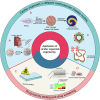Application of human cardiac organoids in cardiovascular disease research
- PMID: 40230411
- PMCID: PMC11994664
- DOI: 10.3389/fcell.2025.1564889
Application of human cardiac organoids in cardiovascular disease research
Abstract
With the progression of cardiovascular disease (CVD) treatment technologies, conventional animal models face limitations in clinical translation due to interspecies variations. Recently, human cardiac organoids (hCOs) have emerged as an innovative platform for CVD research. This review provides a comprehensive overview of the definition, characteristics, classifications, application and development of hCOs. Furthermore, this review examines the application of hCOs in models of myocardial infarction, heart failure, arrhythmias, and congenital heart diseases, highlighting their significance in replicating disease mechanisms and pathophysiological processes. It also explores their potential utility in drug screening and the development of therapeutic strategies. Although challenges persist regarding technical complexity and the standardization of models, the integration of multi-omics and artificial intelligence (AI) technologies offers a promising avenue for the clinical translation of hCOs.
Keywords: cardiovascular disease; clinical translation; disease models; drug screening; human cardiac organoids.
Copyright © 2025 Zhang, Qu, Liu, Cheng and Lei.
Conflict of interest statement
The authors declare that the research was conducted in the absence of any commercial or financial relationships that could be construed as a potential conflict of interest.
Figures


References
-
- Beauchamp P., Moritz W., Kelm J. M., Ullrich N. D., Agarkova I., Anson B. D., et al. (2015). Development and characterization of a scaffold-free 3D spheroid model of induced pluripotent stem cell-derived human cardiomyocytes. Tissue Eng. Part C Methods 21 (8), 852–861. 10.1089/ten.TEC.2014.0376 - DOI - PubMed
Publication types
LinkOut - more resources
Full Text Sources

